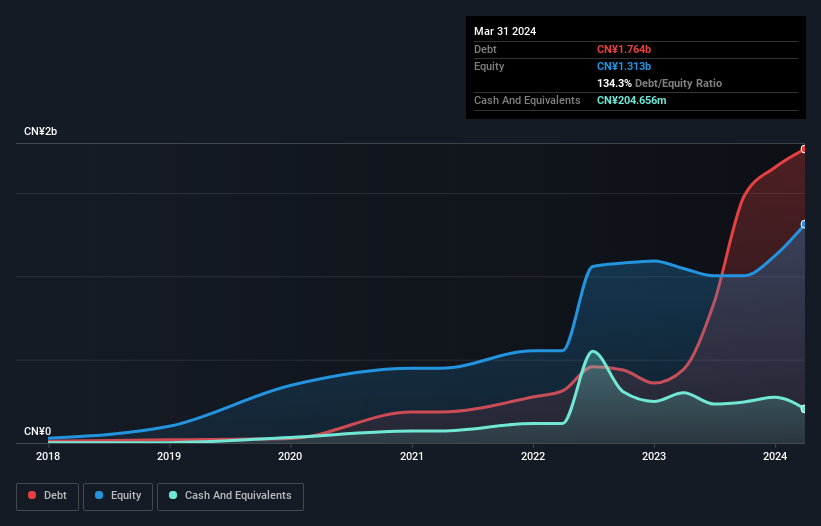- China
- /
- Semiconductors
- /
- SZSE:001309
Shenzhen Techwinsemi Technology (SZSE:001309) Has A Somewhat Strained Balance Sheet

The external fund manager backed by Berkshire Hathaway's Charlie Munger, Li Lu, makes no bones about it when he says 'The biggest investment risk is not the volatility of prices, but whether you will suffer a permanent loss of capital.' So it might be obvious that you need to consider debt, when you think about how risky any given stock is, because too much debt can sink a company. Importantly, Shenzhen Techwinsemi Technology Co., Ltd. (SZSE:001309) does carry debt. But the more important question is: how much risk is that debt creating?
When Is Debt Dangerous?
Debt assists a business until the business has trouble paying it off, either with new capital or with free cash flow. In the worst case scenario, a company can go bankrupt if it cannot pay its creditors. However, a more common (but still painful) scenario is that it has to raise new equity capital at a low price, thus permanently diluting shareholders. Of course, the upside of debt is that it often represents cheap capital, especially when it replaces dilution in a company with the ability to reinvest at high rates of return. When we examine debt levels, we first consider both cash and debt levels, together.
Check out our latest analysis for Shenzhen Techwinsemi Technology
What Is Shenzhen Techwinsemi Technology's Debt?
You can click the graphic below for the historical numbers, but it shows that as of March 2024 Shenzhen Techwinsemi Technology had CN¥1.76b of debt, an increase on CN¥441.7m, over one year. However, because it has a cash reserve of CN¥204.7m, its net debt is less, at about CN¥1.56b.

A Look At Shenzhen Techwinsemi Technology's Liabilities
According to the last reported balance sheet, Shenzhen Techwinsemi Technology had liabilities of CN¥2.25b due within 12 months, and liabilities of CN¥249.7m due beyond 12 months. Offsetting this, it had CN¥204.7m in cash and CN¥257.6m in receivables that were due within 12 months. So its liabilities outweigh the sum of its cash and (near-term) receivables by CN¥2.04b.
Given Shenzhen Techwinsemi Technology has a market capitalization of CN¥10.3b, it's hard to believe these liabilities pose much threat. Having said that, it's clear that we should continue to monitor its balance sheet, lest it change for the worse.
In order to size up a company's debt relative to its earnings, we calculate its net debt divided by its earnings before interest, tax, depreciation, and amortization (EBITDA) and its earnings before interest and tax (EBIT) divided by its interest expense (its interest cover). The advantage of this approach is that we take into account both the absolute quantum of debt (with net debt to EBITDA) and the actual interest expenses associated with that debt (with its interest cover ratio).
Shenzhen Techwinsemi Technology's debt is 4.9 times its EBITDA, and its EBIT cover its interest expense 6.3 times over. Taken together this implies that, while we wouldn't want to see debt levels rise, we think it can handle its current leverage. We also note that Shenzhen Techwinsemi Technology improved its EBIT from a last year's loss to a positive CN¥312m. When analysing debt levels, the balance sheet is the obvious place to start. But it is future earnings, more than anything, that will determine Shenzhen Techwinsemi Technology's ability to maintain a healthy balance sheet going forward. So if you want to see what the professionals think, you might find this free report on analyst profit forecasts to be interesting.
Finally, a business needs free cash flow to pay off debt; accounting profits just don't cut it. So it's worth checking how much of the earnings before interest and tax (EBIT) is backed by free cash flow. Over the last year, Shenzhen Techwinsemi Technology saw substantial negative free cash flow, in total. While that may be a result of expenditure for growth, it does make the debt far more risky.
Our View
We'd go so far as to say Shenzhen Techwinsemi Technology's conversion of EBIT to free cash flow was disappointing. Having said that, its ability to cover its interest expense with its EBIT isn't such a worry. Looking at the balance sheet and taking into account all these factors, we do believe that debt is making Shenzhen Techwinsemi Technology stock a bit risky. That's not necessarily a bad thing, but we'd generally feel more comfortable with less leverage. When analysing debt levels, the balance sheet is the obvious place to start. However, not all investment risk resides within the balance sheet - far from it. These risks can be hard to spot. Every company has them, and we've spotted 2 warning signs for Shenzhen Techwinsemi Technology you should know about.
At the end of the day, it's often better to focus on companies that are free from net debt. You can access our special list of such companies (all with a track record of profit growth). It's free.
New: Manage All Your Stock Portfolios in One Place
We've created the ultimate portfolio companion for stock investors, and it's free.
• Connect an unlimited number of Portfolios and see your total in one currency
• Be alerted to new Warning Signs or Risks via email or mobile
• Track the Fair Value of your stocks
Have feedback on this article? Concerned about the content? Get in touch with us directly. Alternatively, email editorial-team (at) simplywallst.com.
This article by Simply Wall St is general in nature. We provide commentary based on historical data and analyst forecasts only using an unbiased methodology and our articles are not intended to be financial advice. It does not constitute a recommendation to buy or sell any stock, and does not take account of your objectives, or your financial situation. We aim to bring you long-term focused analysis driven by fundamental data. Note that our analysis may not factor in the latest price-sensitive company announcements or qualitative material. Simply Wall St has no position in any stocks mentioned.
About SZSE:001309
Shenzhen Techwinsemi Technology
Develops, manufactures, and sells storage control chips and modules in China and internationally.
Undervalued with high growth potential.
Market Insights
Community Narratives




